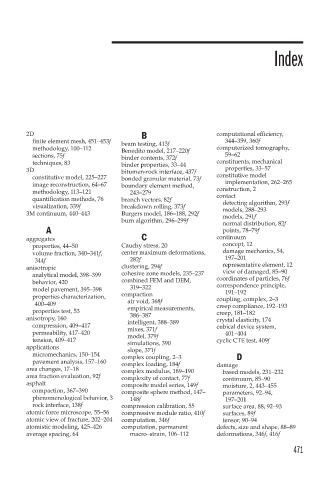Page 479 - Mechanics of Asphalt Microstructure and Micromechanics
P. 479
Index
2D B computational efficiency,
finite element mesh, 451–453f beam testing, 413f 344–359, 360f
methodology, 100–112 Benedito model, 217–220f computerized tomography,
sections, 75f binder contents, 372f 59–62
techniques, 83 binder properties, 33–44 constituents, mechanical
3D bitumen-rock interface, 437f properties, 33–57
constitutive model, 225–227 bonded granular material, 73f constitutive model
image reconstruction, 64–67 boundary element method, implementation, 262–265
methodology, 113–121 243–279 construction, 2
quantification methods, 76 branch vectors, 82f contact
detecting algorithm, 293f
visualization, 339f breakdown rolling, 373f models, 288–293
3M continuum, 440–443 Burgers model, 186–188, 292f models, 291f
burn algorithm, 296–299f
normal distribution, 82f
A points, 78–79f
aggregates C continuum
properties, 44–50 Cauchy stress, 20 concept, 12
volume fraction, 340–341f, center maximum deformations, damage mechanics, 54,
344f 282f 197–201
anisotropic clustering, 294f representative element, 12
view of damaged, 85–90
analytical model, 398–399 cohesive zone models, 235–237 coordinates of particles, 76f
behavior, 420 combined FEM and DEM, correspondence principle,
model pavement, 395–398 319–322 191–192
properties characterization, compaction coupling, complex, 2–3
400–409 air void, 368f creep compliance, 192–193
properties test, 53 empirical measurements, creep, 181–182
386–387
anisotropy, 160 intelligent, 388–389 crystal elasticity, 174
compression, 409–417 mixes, 371f cubical device system,
permeability, 417–420 model, 379f 401–404
tension, 409–417 simulations, 390 cyclic CTE test, 409f
applications slope, 371f
micromechanics, 150–154 complex coupling, 2–3 D
pavement analysis, 157–160 complex loading, 184f damage
area changes, 17–18 complex modulus, 189–190 based models, 231–232
area fraction evaluation, 92f complexity of contact, 77f continuum, 85–90
asphalt composite model series, 149f moisture, 2, 443–455
compaction, 367–390 composite sphere method, 147– parameters, 92–94,
phenomenological behavior, 3 148f 197–201
rock interface, 138f compression calibration, 55 surface area, 88, 92–93
atomic force microscope, 55–56 compressive module ratio, 410f surfaces, 89f
atomic view of fracture, 202–204 computation, 346f tensor, 90–94
atomistic modeling, 425–426 computation, permanent defects, size and shape, 88–89
average spacing, 64 macro–strain, 106–112 deformations, 346f, 416f
471

